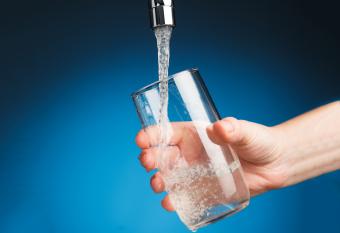How To Make A Water Filter Science Project
Homemade Water Filter Scientific discipline Project

70 percent of the Earth is covered with water. Still, only about iii percent that can exist used for drinking water. While many people in the United States have clean, drinkable water from their kitchen sink, near of the people around the world do not have access to clean h2o and must boil or filter their water. Y'all can teach your students how to water filters work with this easy project.
Homemade Simple Water Filter
You tin can easily brand a water filter with children using recycled materials found at abode. This project is best for children in grades three through half-dozen, but it will work for all ages. Construction of the homemade water filter will accept about an hour to build. Testing of the water filter tin have anywhere from an hour to several hours depending on how fast the water drips. By using natural materials that mimic the h2o cycle of the Earth, children can larn how the procedure of infiltration works and create a water filter that works.

Materials
- Plastic soda or juice bottle
- Vase or tall drinking drinking glass
- Gravel or small stones
- Clean Sand
- Activated Charcoal
- Cotton wool balls, pocket-sized cloth or coffee filter
- Gardening dirt
- Water
- Scissors or knife
Instructions
- Cut off the bottom of an former plastic soda or juice bottle using scissors or a pocketknife.
- Identify the bottle upside downwards into the vase or tall drinking drinking glass.
- Place cotton balls, cloth, or a java filter inside the bottle every bit the commencement layer. The first layer should exist about 1 to two inches thick.
- Add an inch of activated charcoal as the second layer on top of the cotton layer.
- Over the charcoal, add together about two inches of gravel or pocket-sized stones as the third layer.
- Add about three to iv inches of make clean sand on top of the gravel.
- Add together gravel to the bottle as the concluding layer. Leave nigh a half inch of space from the height of the upside downwards bottle.
- Add dirt to a glass of water to create muddy water. Alternatively, get creative and add other things like glitter, beads, cooking oil or other materials to make dirty water.
- Cascade the glass of muddy water on top of the homemade water filter and watch the water drip clean into the glass below.
How to Exam the Water

For this experiment, it is all-time to test the water before and after the filtration.
- To start, ask the child to make a hypothesis or prediction nearly the experiment.
- Pour two spectacles of water from the kitchen faucet. The kickoff drinking glass volition serve as the command. The second glass volition exist "muddied."
- Dirty the "dirty" water with materials plant effectually the house. The "dirty" water tin contain things similar clay, potting soil, glitter, dish detergent, kitchen oils, among other materials plant around the house.
- Have the children test the two glasses of water with a home drinking water test kit, like the First Alert Drinking Water Test Kit.
Pour each glass of water through the bootleg h2o filter. Collect the filtered water in a glass. Test both water samples afterward filtration using the aforementioned home drinking water test kit. Compare all the h2o samples. Did the homemade water filter make clean the "dirty" water sample? Is the filtered "dirty" water now the aforementioned as the control?
Testing Variables
Many of the materials used to make a homemade water filter can be plant around the firm and recycled for the purpose of this project. A small washcloth, chamois cloth or coffee filter can be used instead of cotton balls. If gravel is non bachelor, small pebbles or stones tin exist used. If a plastic soda bottle cannot be recycled, a big funnel tin can also be used instead.
As part of the experiment, children tin test different materials to determine which materials produce the cleanest water. Instead of using sand and gravel, children could attempt rice and sponges. Kids can build several water filters using dissimilar materials to decide which materials filter "dirty" water into clean water.
How the Filter Works
Each layer of the homemade water filter has a purpose. Gravel or modest stones are used to filter out large sediments, like leaves or insects, whereas sand is used to remove fine impurities. Finally, the activated charcoal removes contaminants and impurities through chemical absorption.
Larn About the Water Cycle
A bootleg water filter is a uncomplicated activity that children will dearest. Not only does the projection assist children learn most the water cycle, but it'southward a easily-on experiment using common materials found effectually the business firm or outside that will fascinate them. The Earth naturally filters water every bit it is absorbed into aquifers in the ground. The natural soil of the ground filters leaves, insects, and other droppings out of the water as function of the infiltration process of the water wheel. Unfortunately, due to pollution such as backyard care products, household chemicals, and fertilizers, ground water tin can become contaminated and unsafe to potable.
© 2022 LoveToKnow Media. All rights reserved.
How To Make A Water Filter Science Project,
Source: https://science.lovetoknow.com/science-fair-projects/homemade-water-filter-science-project
Posted by: arellanoexproul.blogspot.com



0 Response to "How To Make A Water Filter Science Project"
Post a Comment